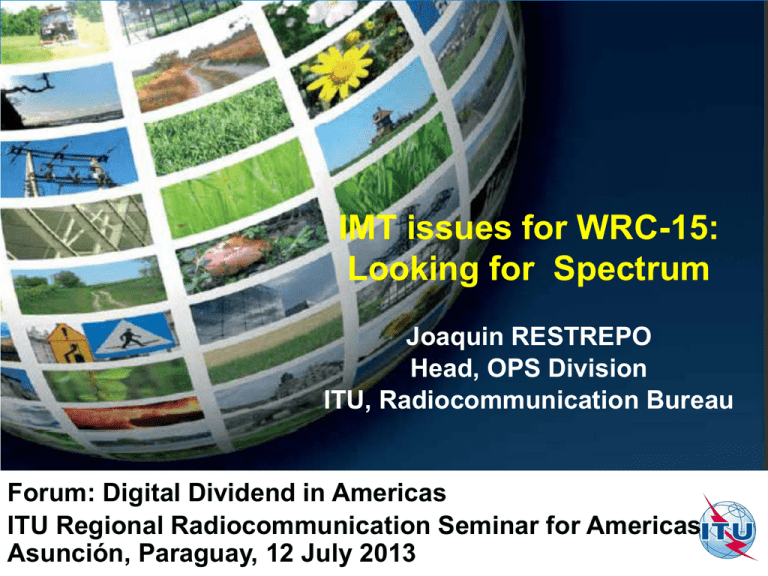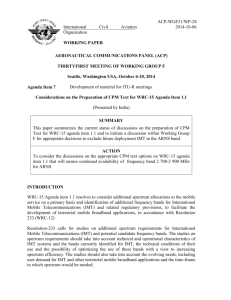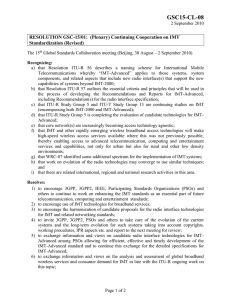IMT issues for WRC-15: Looking for Spectrum
advertisement

IMT issues for WRC-15: Looking for Spectrum Joaquin RESTREPO Head, OPS Division ITU, Radiocommunication Bureau Forum: Digital Dividend in Americas ITU Regional Radiocommunication Seminar for Americas Asunción, Paraguay, 12 July 2013 IMT on ITU-R Since 25 years ago, ITU has been coordinating efforts of government and industry and private sector in the development of a Global Broadband Multimedia International Mobile Telecommunication System, known as IMT. Since 2000, the world has seen the introduction of the first family of standards derived from the IMT concept. Nowadays there are more than 2 billion IMT subscribers in the world! http://www.itu.int/ITU-R/go/imt-advanced 2 ITU-R WP5D: IMT Systems Overall radio system aspects of (IMT) systems - issues related to the terrestrial component of IMT, including technical, operational and spectrum-related issues to meet the objectives of future IMT systems - works closely with WP4C on issues related to the satellite component of IMT. - overall maintenance of existing, and the development of new, Rec. on the terrestrial component of IMT - liaison with ITU-T on the standardization activities of IMT and with ITU-D in relation to IMT in developing countries. - Strong cooperative efforts with external organizations and well-known standards development organizations http://www.itu.int/ITU-R/go/rwp5d 3 IMT-x and xG Families IMT-2000, in use for over a decade since 2.000, has been widely deployed; it is also referred commercially as 3G. The term 4G remains undefined: - Some operators (countries) apply to technologies complying IMT-Advanced, and make difference from so-called 3.5G - Other operators (countries) apply to any technology beyond 3G (i.e. IMT-2000) RA-12 agreed that IMT encompass both IMT-2000 and IMT-Advanced 4 IMT Standards IMT-2000 IMT-Advanced ITU-R M.1457-10 (06/2011): Detailed specifications of the terrestrial radio ITU-R M.2012 (01/2012): Detailed specifications of the terrestrial radio interfaces of ITU-R Recommendation interfaces of International Mobile Telecommunications-2000 (IMT-2000) International Mobile Telecommunications Advanced (IMT-Advanced) 1- high degree of commonality of design worldwide; 1- high degree of commonality of functionality worldwide while retaining the flexibility to support a wide range of services and applications in a cost-efficient manner; 2- compatibility of services within IMT-2000 and with the fixed networks; 2- compatibility of services within IMT and with fixed networks; 3- high quality; 4- worldwide roaming capability; Main Technical 5- small terminal for worldwide use; Criteria 6- capability for multimedia applications, and a wide range of services and terminals. 1- IMT-2000 CDMA Direct Spread 2– IMT-2000 CDMA Multi-Carrier Recognized Radio 3– IMT-2000 CDMA TDD Interfaces 4– IMT-2000 TDMA Single-Carrier 5– IMT-2000 FDMA/TDMA 6– IMT-2000 OFDMA TDD WMAN 3- high-quality mobile services; 4- worldwide roaming capability; 5- user equipment suitable for worldwide use; 6- user-friendly applications, services and equipment; 7- capability of interworking with other radio access systems; 8- enhanced peak data rates to support advanced services and applications (100 Mbit/s for high and 1 Gbit/s for low mobility were established as targets for research; (rates surced from ITU-R M.1645) 1- LTE-Advanced 2- WirelessMAN-Advanced 5 Why more spectrum for BB? 6 Why more spectrum for BB? 7 SPECTRUM ALLOCATIONS - All Spectrum Bands are already allocated - (Innal: RR, IFT; nal.: NAFT) Effective Assignments, and intensive exploitation of frequencies below 3 GHz (Administrations) Attending the needs for more Spectrum from some services, is only possible by modifying the current allocation of other ones A “refarming” is necessary: where to migrate an incumbent service to let the room to a new comer? How to avoid a “domino” effect? 8 SPECTRUM ALLOCATIONS Responding to growing Capacity Demand (Mbps) can be improved by: -New technologies: better spectrum efficiency (Mbps/MHz); e.g. TDT -Increasing Radio Stations (lower coverage (traffic)/Station); e.g. Femtocells -Allocating more Spectrum - Prevent Domino’s Effect: - Compare and prioritize growing demands (and social impact) - Foster network updating (spectrum efficiency) 9 IMT in Americas (As in RR) 10 WRC-15 WRC-15 Agenda Items 1.1 to consider additional spectrum allocations to the mobile service on a primary basis and identification of additional frequency bands for International Mobile Telecommunications (IMT) and related regulatory provisions, to facilitate the development of terrestrial mobile broadband applications, in accordance with Resolution COM6/8 (WRC-12); 1.2 to examine the results of ITU-R studies, in accordance with Resolution COM5/10 (WRC-12), on the use of the frequency band 694-790 MHz by the mobile, except aeronautical mobile, service in Region 1 and take the appropriate measures; 11 IMT during WRC-12 IMT Services (Mobile Broadband): identification Band (MHz) 98450-470 1 2 2 2 3 698-960 710-2 025 110-2 200 300-2 400 500-2 690 400-3 600 Radio Rules Footnotes 5.286AA 5.313A, 5.317A 5.384A, 5.388 5.388 5.384A 5.384A 5.430A, 5.432A, 5.432B, 5.433A 698-960: Includes the Digital Dividend 12 IMT in Americas (As in RR) Band (MHz) 450-470 698-960 1 710-2 025 2 110-2 200 2 300-2 400 2 500-2 690 3 400-3 600 13 IMT in Americas (As in RR) Band (MHz) 450-470 698-960 1 710-2 025 2 110-2 200 2 300-2 400 2 500-2 690 3 400-3 600 14 IMT in Americas (As in RR) Band (MHz) 450-470 698-960 1 710-2 025 2 110-2 200 2 300-2 400 2 500-2 690 3 400-3 600 15 IMT in Americas (As in RR) Band (MHz) 450-470 698-960 1 710-2 025 2 110-2 200 2 300-2 400 2 500-2 690 3 400-3 600 16 IMT in Americas (As in RR) Band (MHz) 450-470 698-960 1 710-2 025 2 110-2 200 2 300-2 400 2 500-2 690 3 400-3 600 17 IMT in Americas (As in RR) Band (MHz) 450-470 698-960 1 710-2 025 2 110-2 200 2 300-2 400 2 500-2 690 3 400-3 600 18 IMT in Americas (As in RR) Band (MHz) 450-470 698-960 1 710-2 025 2 110-2 200 2 300-2 400 2 500-2 690 3 400-3 600 19 IMT in Americas (As in RR) Band (MHz) 450-470 698-960 1 710-2 025 2 110-2 200 2 300-2 400 2 500-2 690 3 400-3 600 20 Importance of spectrum harmonization of mobile broadband in reducing the digital divide Spectrum harmonization reduces the cost of mobile hardware (i.e. cheaper smartphones) Enables global roaming. Reduces the complexity of the radio design. Reduces interference with adjacent services and helps managing cross-border interference. Cost of infrastructure is reduced, benefit passed on to users through a reduced cost of service. Increased access to mobile broadband will increase ICT literacy. Development of relevant mobile applications will add value to users over time. 2007-2012 …a difficult start for global harmonisation of mobile WRC-07: mobile spectrum allocations were not harmonized throughout the world. Historical problems due to the legacy allocations of 2G spectrum bands (CDMA in 850 and GSM in 900 MHz). Non-harmonized mobile bands below 1 GHz as a result. Digital Dividend bands: bands adopted in USA Allocated in 2007, it resulted in a complex and fragmented market, requiring two different types of incompatible handsets. Auction considered allocating bands for public safety communications. LTE networks have been deployed. Also adopted by Canada (with some mod.) Market size: 350 million UL 698 DL 716 728 US 700 MHz Pairing 1 746 MHz UL DL 746 757 776 787 MHz DL 758 Pairing 2 UL 775 788 PPDR 805 MHz Digital Dividend bands: bands adopted in Europe In 2009, Europe (CEPT, 48 countries) adopted a regionally harmonised band for mobile in 800 MHz, (two blocks of 30 MHz). Germany, Sweden, Spain, Switzerland, Italy and France have already auctioned these bands and deployment of LTE networks started. Market size: 800 million CEPT 800 MHz 791 UL DL 821 832 862 MHz Digital Dividend bands: bands for Asia Pacific (also being adopted by several countries in Latin America) In 2010, the Asia Pacific Telecommunity (APT) adopted two paired blocks (2 x 45 MHz) in 700 MHz plus one block for TDD, covering the entire 703-803 MHz band. Countries in Asia, the Pacific and Latin America have already announced its adoption. Market size: over 4 billion 718 748 773 UL DL UL 703 803 MHz Duplexer 1 DL 733 758 Duplexer 2 788 MHz APT 700 MHz The overall picture: Sub-1GHz mobile spectrum: 700, 800, 850, 900 MHz: Present use and bands adopted before 2012 900 MHz 915 880 850 MHz UL 824 CEPT 800 MHz 748 773 733 UL DL 698 716 728 Duplexer 1 788 MHz Pairing 1 APT 700 MHz US 700 MHz 746 MHz UL DL 746 757 776 DL 758 Pairing 2 787 MHz UL 775 832 862 MHz Duplexer 2 DL 758 894 MHz UL 821 DL 703 869 803 MHz UL UL 925 DL 849 DL 791 718 DL UL 788 PPDR 805 MHz Bands specified by CITEL as options for the Americas region 960 Current uptake of digital dividend bands for mobile broadband Asia Pacific (APT) harmonized band plan: - Region 3 (Asia Pacific): Japan, Australia, Taiwan, Papua New Guinea, Tonga, India. - Region 2 (Americas): Mexico, Chile, Colombia, Costa Rica. European (CEPT) harmonized band plan: - Region 1 (Europe): France, Germany, Sweden, Italy, Spain, Denmark, UK, Netherlands, Switzerland. US band plan: - Region 2 (Americas): US, Canada WRC-12 decisions At WRC-12 it was decided to allocate the 700 MHz band for the mobile service globally, as well as its identification for IMT services, in addition to 800 MHz, with commencement date end of 2015. This decision illustrates the global consensus for harmonization of mobile spectrum bands. Conclusions Reduction of the digital divide through better, more efficient and cost effective broadband The spectrum challenges: - Sub -1 GHz spectrum: best bands for wide coverage of mobile broadband in rural areas. - Availability and allocation: digital dividend and migration to digital television. - Efficient utilization: through coordinated use. - Harmonization: makes it cost effective and interoperable. 29 Conclusions The steps for success… Regional harmonization is necessary Implement the most efficient band allocations Negotiation frameworks for frequency coordination Existing services to be re-deployed and protected Implement an appropriate licensing process Thank you… www.itu.int



